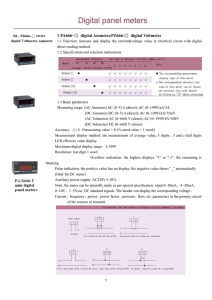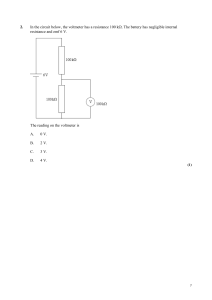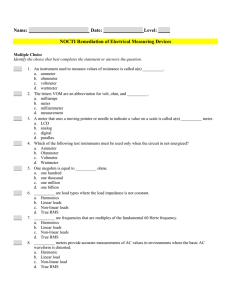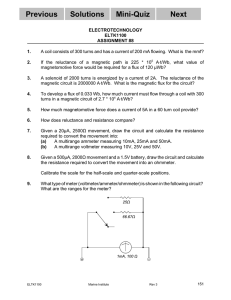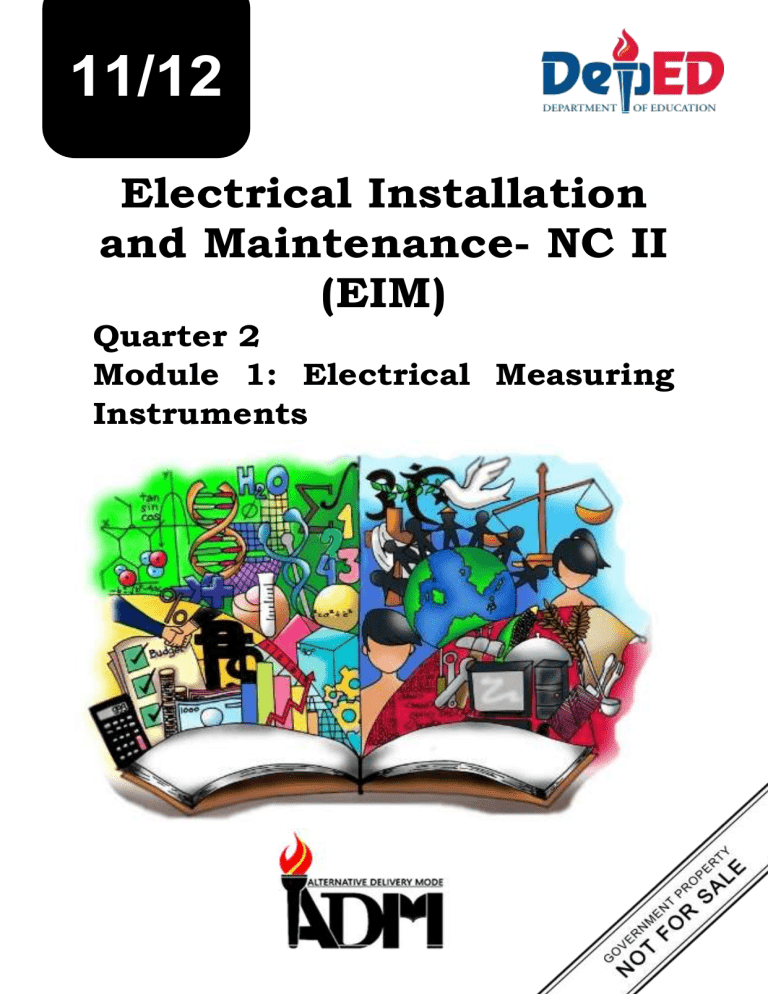
11/12 Electrical Installation and Maintenance- NC II (EIM) Quarter 2 Module 1: Electrical Measuring Instruments TVL – Grade 11/12 Alternative Delivery Mode Quarter 2 – Module 1: Electrical Measuring Instruments First Edition, 2020 Republic Act 8293, section 176 states that: No copyright shall subsist in any work of the Government of the Philippines. However, prior approval of the government agency or office wherein the work is created shall be necessary for exploitation of such work for profit. Such agency or office may, among other things, impose as a condition the payment of royalties. Borrowed materials (i.e., songs, stories, poems, pictures, photos, brand names, trademarks, etc.) included in this module are owned by their respective copyright holders. Every effort has been exerted to locate and seek permission to use these materials from their respective copyright owners. The publisher and authors do not represent nor claim ownership over them. Published by the Department of Education Secretary: Leonor Magtolis Briones Undersecretary: Diosdado M. San Antonio Development Team of the Module Writers: Francis E. Cadallo Editors: Reviewers: Illustrator: Francis E. Cadallo Layout Artist:, Fernando Galera Management Team: Salustiano T. Jimenez Dexter Y. Aguilar Cherry D. Catadman Maria Ligaya G. Panganiban Rose Marie A. Vailoces Printed in the Philippines by: Bais City National High School Department of Education – Region VII- Bais City Division Office Address: Telefax: E-mail Address: Laurel St. Bais City (035) 402-3172, 522-1907 bais.city@deped.gov.ph 11/12 EIM NC II Quarter 2 – Module 1: Electrical Measuring Instruments Introductory Message For the facilitator: Welcome to the EIM NC II-Grade 11/12 Alternative Delivery Mode (ADM) Module on Electrical Measuring Instruments This module was collaboratively designed, developed and reviewed by educators both from public and private institutions to assist you, the teacher or facilitator in helping the learners meet the standards set by the K to 12 Curriculum while overcoming their personal, social, and economic constraints in schooling. This learning resource hopes to engage the learners into guided and independent learning activities at their own pace and time. Furthermore, this also aims to help learners acquire the needed 21st century skills while taking into consideration their needs and circumstances. In addition to the material in the main text, you will also see this box in the body of the module: Notes to the Teacher This contains helpful tips or strategies that will help you in guiding the learners. As a facilitator you are expected to orient the learners on how to use this module. You also need to keep track of the learners' progress while allowing them to manage their own learning. Furthermore, you are expected to encourage and assist the learners as they do the tasks included in the module. i For the learner: Welcome to the EIM NC II-Grade 11/12 Alternative Delivery Mode (ADM) Module on Electrical Measuring Instruments The hand is one of the most symbolized part of the human body. It is often used to depict skill, action and purpose. Through our hands we may learn, create and accomplish. Hence, the hand in this learning resource signifies that you as a learner is capable and empowered to successfully achieve the relevant competencies and skills at your own pace and time. Your academic success lies in your own hands! This module was designed to provide you with fun and meaningful opportunities for guided and independent learning at your own pace and time. You will be enabled to process the contents of the learning resource while being an active learner. This module has the following parts and corresponding icons: What I Need to Know This will give you an idea of the skills or competencies you are expected to learn in the module. What I Know This part includes an activity that aims to check what you already know about the lesson to take. If you get all the answers correct (100%), you may decide to skip this module. What’s In This is a brief drill or review to help you link the current lesson with the previous one. What’s New In this portion, the new lesson will be introduced to you in various ways such as a story, a song, a poem, a problem opener, an activity or a situation. What is It This section provides a brief discussion of the lesson. This aims to help you discover and understand new concepts and skills. What’s More This comprises activities for independent practice to solidify your understanding and skills of the topic. You may check the answers to the exercises using the Answer Key at the end of the module. What I Have Learned This includes questions or blank sentence/paragraph to be filled in to process what you learned from the lesson. ii What I Can Do This section provides an activity which will help you transfer your new knowledge or skill into real life situations or concerns. Assessment This is a task which aims to evaluate your level of mastery in achieving the learning competency. Additional Activities In this portion, another activity will be given to you to enrich your knowledge or skill of the lesson learned. This also tends retention of learned concepts. Answer Key This contains answers to all activities in the module. At the end of this module you will also find: References This is a list of all sources used in developing this module. The following are some reminders in using this module: 1. Use the module with care. Do not put unnecessary mark/s on any part of the module. Use a separate sheet of paper in answering the exercises. 2. Don’t forget to answer What I Know before moving on to the other activities included in the module. 3. Read the instruction carefully before doing each task. 4. Observe honesty and integrity in doing the tasks and checking your answers. 5. Finish the task at hand before proceeding to the next. 6. Return this module to your teacher/facilitator once you are through with it. If you encounter any difficulty in answering the tasks in this module, do not hesitate to consult your teacher or facilitator. Always bear in mind that you are not alone. We hope that through this material, you will experience meaningful learning and gain deep understanding of the relevant competencies. You can do it! iii What I Need to Know This module was designed and written with you in mind. It is here to help you master the knowledge and skills in Electrical Installation and Maintenance. The scope of this module permits it to be used in many different learning situations. The language used recognizes the diverse vocabulary level of students. The lessons are arranged to follow the standard sequence of the course. But the order in which you read them can be changed to correspond with the textbook you are now using. The module has only 1 lesson: Electrical Measuring Instruments After going through this module, you are expected to: 1. Identify measuring tools for object or component to be measured 2. Select measuring tools in line with job requirements 1 What I Know Choose the letter of the best answer. Write the chosen letter on a separate sheet of paper. 1. A tool a. b. c. d. measures the total voltage of the source/circuit. Voltmeter Ammeter Ohmmeter Wattmeter 2. A tool a. b. c. d. which measures the total current running in a circuit. Voltmeter Ammeter Ohmmeter Wattmeter 3. A tool which measures, voltage in volts, DC current in milliamperes, resistance in ohms, and to check the continuity of a conductor with the use of its ohmmeter. a. kWh meter b. Many meter c. Multiple-meter d. VOM 4. A small instrument that provides direct reading of insulation resistance in ohms or megohms. a. Voltmeter b. Ammeter c. Megohmmeter d. Wattmeter 5. An electric meter that measures the amount of electrical energy in kilowatts per hour that was consumed in the house. a. kWh meter b. Many meter c. Multiple-meter d. VOM 2 Measuring tools In this lesson, you will learn the different measuring tools and the purpose of each tool. What’s In Instruction: Study the given picture and provide the actual measurement shown of the measuring devices in a separate sheet. . 1. 2. 3. 3 What’s New Complete the table below which shows some tools by filling in the missing names and uses, you should do this activity prior to “What is it”. TOOL NAME USE A tool which measures the total current running in a circuit A________________ Voltmeter 4 What is It Voltmeter A tool measures the total voltage of the source/circuit. The two test probes are connected in the live and neutral terminal Ammeter A tool which measures the total current running in a circuit, the test probes of this meter are connected in series of the load to get the correct measurement of electric current Analog Multi-tester/VOM Digital Multi-tester/VOM A tool which measures, voltage in volts, DC current in milliamperes, resistance in ohms, and to check the continuity of a conductor with the use of its ohmmeter function. The term “VOM” refers to Volt-Ohm-milliammeter. Megohmmeter/Megger tester The Megger insulation tester is a small instrument that provides direct reading of insulation resistance in ohms or megohms. 5 Clamp meter A clamp meter is an electrical testing tool that combines a basic VOM with a current tester. Its clamp measures current, and probes measures volts, ohms, and milliamperes. The hinged jaw attached to the device, allows electricians to clamp the jaws around a wire then measure current in that circuit without cutting the wire or de-energizing it. Kilowatt-hour meter/kWh meter kWh meter is an electric meter that measures the amount of electrical energy in kWh that was consumed in the house. 6 What’s More Instruction: In a separate sheet, identify the given picture of electrical measuring tools and provide situations when will you use the tools in your job as an electrician. 7 What I Have Learned Instruction: In a separate sheet, answer directly the definition of the given measuring tool. Symbols Definition 1. VOM 2. Clamp meter 3. Voltmeter 4. Ammeter 5. kWh meter 8 What I Can Do Instruction: Study the given situation and select an appropriate electrical measuring tool for the job. Write your answer in a separate sheet. 1. The electrician wants to measure the total current of the circuit, he disconnects the one wire in series of the load terminal for testing (refer to the picture), what measuring tool he needs to use for this job? 2. The electrician wants to measure the total voltage in the convenience outlet, he also needs to measure the total resistance of the motor coil, and check its power cord’s continuity, and measure the total DC current in an auxiliary device, what specific tool he needs to use? 3. The electrician wants to measure the total current of the circuit, without disconnecting the conductors, what measuring tool he needs to use for this job? 4. The electric company needs to measure the total energy consumed by the households, what measuring tool the company needs to use? 5. The electrician needs to measure the resistance of the circuit’s insulator, what tool he needs to use? 9 Assessment Multiple Choice. Choose the letter of the best answer. Write the chosen letter on a separate sheet of paper. 1. What does VOM stands for? A. Very open meter B. Valve-on-Wheels C. Volt-ohm-milliammeter D. Voltmeter,ohmmeter,multimeter 2. What does kWh stands for? A. kilowatt-hour B. kindwondhep C. Kilogram D. Kilometer per hour 3. Which of the following measuring tools that can carry multiple functions? A. Voltmeter B. Ammeter C. VOM D. kWh 4. Which of the following measuring tools that can measure amperes without disconnecting the flow of the current nor cutting the wires? A. Voltmeter B. Ammeter C. Multi-meter D. Clamp meter 5. Which of the following measuring tools that can measure total voltage only? A. Voltmeter B. Ammeter C. Multi-meter D. Clamp meter 10 Additional Activities Instruction: Study the circuit below select the selector knob of the VOM by drawing a line and connect the test probes to measure the voltage. Draw your representation of answer. Write your answer in a separate piece of paper. CB C.O 11 Answer Key 1. 2. 3. 4. 5. C A C D A 1. 2. 3. 4. 5. Assessment A B D C A What I Know References 1. TR – Electrical Installation and Maintenance NC II (Amended) Promulgated, ENGR. HIPOLITO A. LEONCIO, PEE- Managing Director, Dec. 16, 2015 2. Learner’s Material, Electrical Installation and Maintenance, Roman A. Cabusora, Jr., Marino C. Cueto., First Edition, 2014 3. K-12 Industrial Arts, Electrical Installation and Maintenance, Curriculum Guide, May 2016 12 For inquiries or feedback, please write or call: Department of Education – Bais City Division, Learning Resource Management Section Laurel St. Bais City,Negros Oriental, Philippines, 6206 Telefax: (035) 402-3172, 522-1907 Email Address: bais.city@deped.gov.ph
